Has anyone ever handed you a beer in an odd-shaped glass and left you wondering why? You’re not alone; many people don’t realise that different beers require distinct glassware. This blog post will guide you through the fascinating world of beer glasses, offering knowledge on types, shapes and their specific uses.
We’ll also delve into serving techniques to optimise your beer-drinking experience. Ready for a flavourful journey? Let’s dive in!
Key Takeaways
- Different types of beer require specific types of glassware to enhance the flavors and aromas.
- Pint glasses are versatile and can be used for any type of beer, while Belgian, tulip, and goblet glasses are designed for specific styles like Belgian ales or strong dark beers.
- Pilsner glasses are slender and tall to maintain carbonation and showcase the golden color.
- Proper glassware care includes rinsing with warm water, gentle washing with mild dish soap, and air drying upside down.
Understanding Beer Glass Types

There are various types of beer glasses, such as pint glasses, beer mugs and steins, Belgian, tulip, and goblet glasses, pilsner glasses, sampler glasses, and stemware with footed bases.
Pint Glasses

Pint glasses are very popular. They can have many uses and fit any type of beer. The American pint is the most common one you will find. They help to bring out great smells and tastes in your beer.
Glass making has grown a lot, so now we use glass for beer more than ever before!
Beer Mugs and Beer Steins
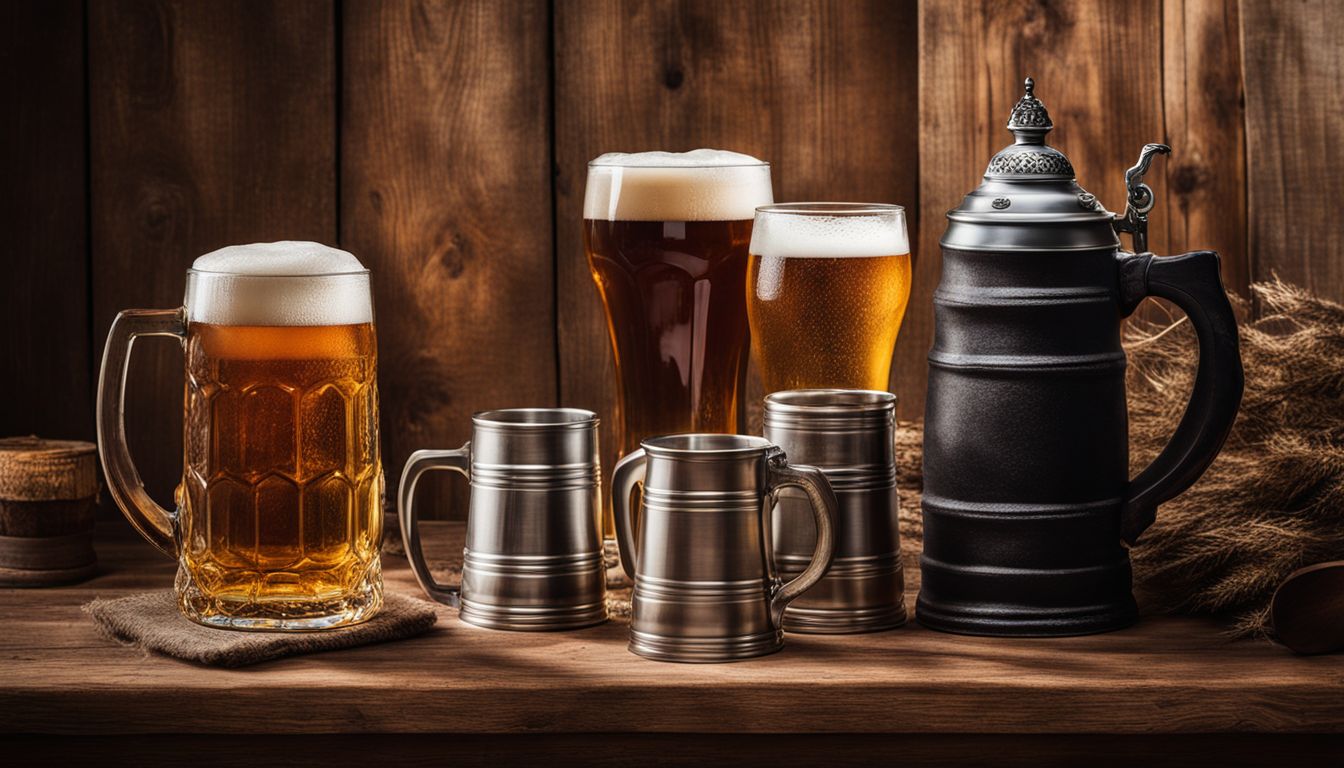
Beer mugs and beer steins are popular choices for enjoying a cold brew. These sturdy, thick-glassed vessels often have handles, making them easy to hold and preventing heat transfer from your hand to the beer.
Beer mugs usually have a cylindrical shape with a wide mouth, allowing for easy drinking and enhancing the aroma of your favorite brew. On the other hand, beer steins are typically larger and heavier than mugs, often decorated with intricate designs or even lids.
They were traditionally used in Germany to keep insects out of the drink during outdoor gatherings. Both beer mugs and beer steins provide a classic and nostalgic way to savor your favorite beers.
– Belgian, Tulip, and Goblet Beer Glasses
Belgian, tulip, and goblet glasses are designed specifically for certain types of beers like Belgian ales or strong dark beers. The tulip glass has a flared lip that helps trap aromas while capturing carbonation at the base to create visually appealing bubbles dancing upwards through the liquid.
Belgian, Tulip, and Goblet Beer Glasses

Belgian, tulip, and goblet beer glasses are popular choices for serving certain types of beers. These glasses have unique shapes that enhance the aroma and flavors of the beer. Belgian beer glasses have a stem and a wide bowl, which allows for better head retention and showcases the color of the beer.
The tulip glass has a flared top that captures aromas while directing them towards your nose. Goblet glasses are similar to chalices with a thick base and large bowl, making them ideal for heavy-bodied beers like stouts and strong ales.
So if you’re looking to elevate your drinking experience, consider using these specialized beer glasses based on the type of brew you’re enjoying!
Pilsner Glasses

Pilsner glasses are specifically designed to enhance the taste and visual presentation of pilsner beers. These glasses have a slender, tall shape with a narrow base that widens towards the top.
The elongated design helps maintain the carbonation and showcases the beer’s golden color and foamy head. Pilsner glasses also highlight the hop aroma and provide a smooth drinking experience.
So, if you’re enjoying a refreshing pilsner, reach for a pilsner glass to elevate your beer-drinking experience!
Beer Sampler Glasses

Beer sampler glasses are small-sized glasses designed for tasting and sampling different types of beers. They typically hold around 4 to 6 ounces of beer, allowing you to try a variety without having to commit to a full-sized glass.
These glasses are great for exploring new flavors and styles, as they allow you to fully appreciate the aromas and flavors of each beer. Beer samplers often come in sets with multiple glasses, making them perfect for hosting beer tastings or sharing with friends.
So if you’re looking to expand your beer palate or want to experience a range of flavors in one sitting, beer sampler glasses are a must-have addition to your glassware collection.
Stemware and Footed Beer Glasses
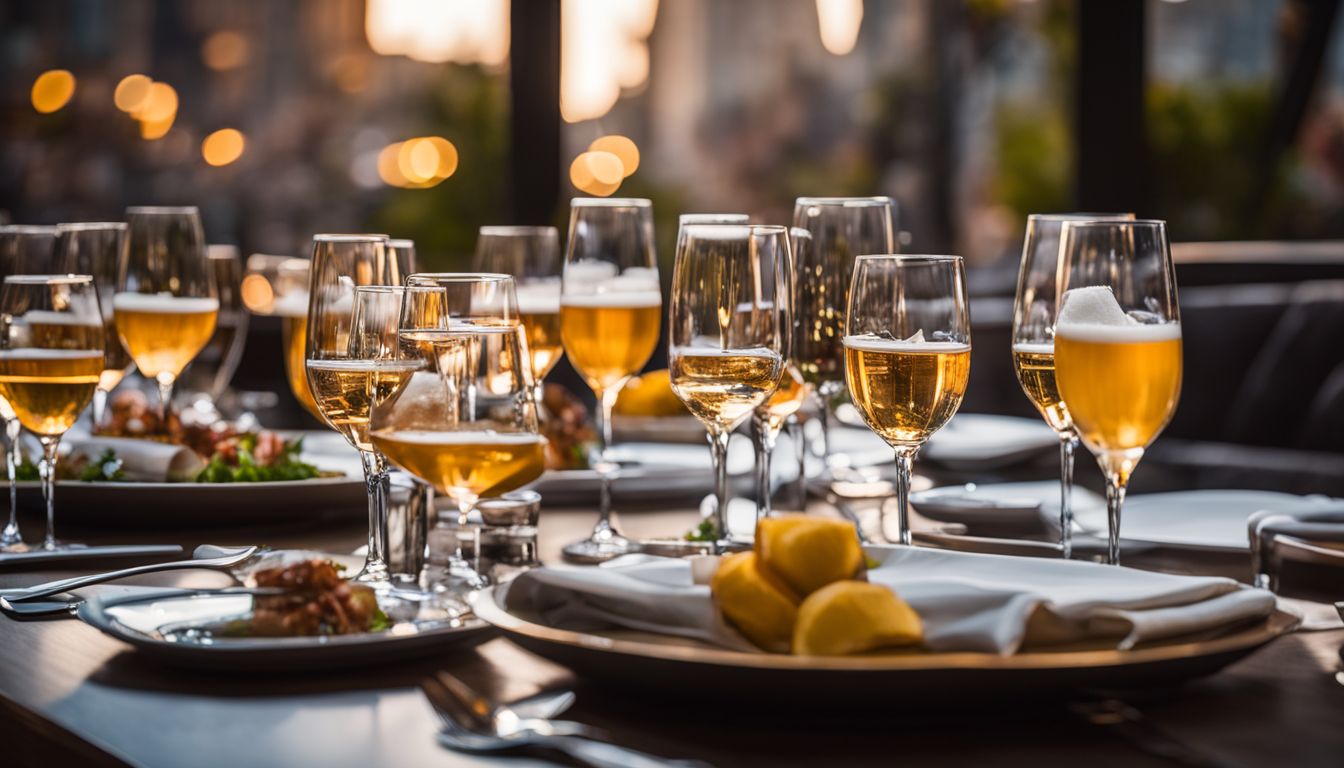
Stemware and footed beer glasses are elegant and sophisticated options for serving beer. These glasses have a tall stem attached to a wide bowl, which sits on top of a sturdy base.
Stemware and footed beer glasses are commonly used for serving lighter styles of beer, such as lagers, pilsners, and wheat beers.
One important benefit of using stemware or footed glasses is that they keep the beer colder for longer. The long stem allows you to hold the glass without warming up the liquid inside.
This helps maintain the ideal temperature of your beer throughout your drinking experience.
Another advantage of stemware and footed glasses is their ability to showcase the color, clarity, and carbonation of the beer. The clear glass design allows you to appreciate the appearance of your brew, which can add to your overall enjoyment.
The Importance of Proper Glassware
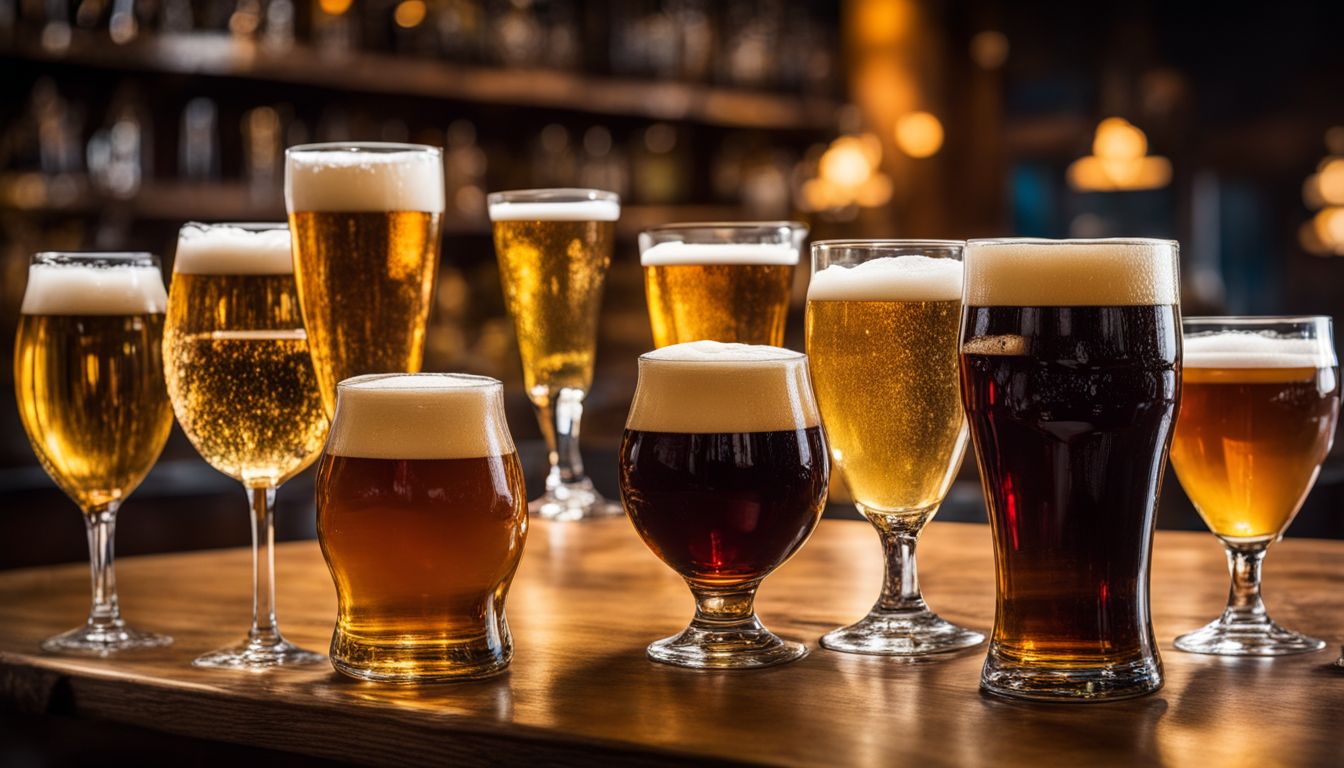
Proper glassware is key to enhancing the flavors and aromas of beer, showcasing different beer styles, and creating an appealing visual presentation.
Enhancing beer flavors and aromas

Using the right beer glass can enhance the flavors and aromas of your favorite brew. Different glass shapes and sizes are designed to showcase specific characteristics of different beer styles.
For example, tulip glasses with their narrow opening help capture and concentrate the complex aromas of hop-forward IPAs, while pint glasses are perfect for enjoying a refreshing lager or ale.
When you drink beer from a glass, you can see its color and clarity better, which adds to the overall sensory experience. So next time you pour yourself a pint, consider reaching for the appropriate glassware to elevate your enjoyment of that delightful beverage.
Showcasing beer styles
Beer glassware plays a crucial role in showcasing the unique characteristics and styles of different beers. The shape, size, and design of a beer glass can affect how the beer looks, smells, and tastes.
For example, tulip glasses are ideal for capturing the aromas of aromatic craft beers like IPAs and Belgian ales. Pilsner glasses with their tall, slender shape showcase the clarity and effervescence of pilsners and lagers.
Stout glasses with their wide mouths allow for sipping creamy stouts with all their rich flavors intact. By using the right beer glass for each style, you can fully appreciate and enjoy the nuances of your favorite brews.
Creating a visually appealing presentation

The way beer is presented in a glass can greatly enhance its overall appeal. A visually appealing presentation adds to the enjoyment and experience of drinking beer. When beer is poured into a well-chosen glass, it not only looks more inviting but also showcases its unique color, clarity, and carbonation.
For example, tulip glasses are shaped like a flower with a wide bowl and narrow top, which helps trap aromas and allows the drinker to fully appreciate the beer’s fragrance. Similarly, pilsner glasses are tall and slender, showcasing the golden color of light lagers.
The right glassware can elevate your beer-drinking experience by making it more visually appealing.
Techniques for Serving Beer
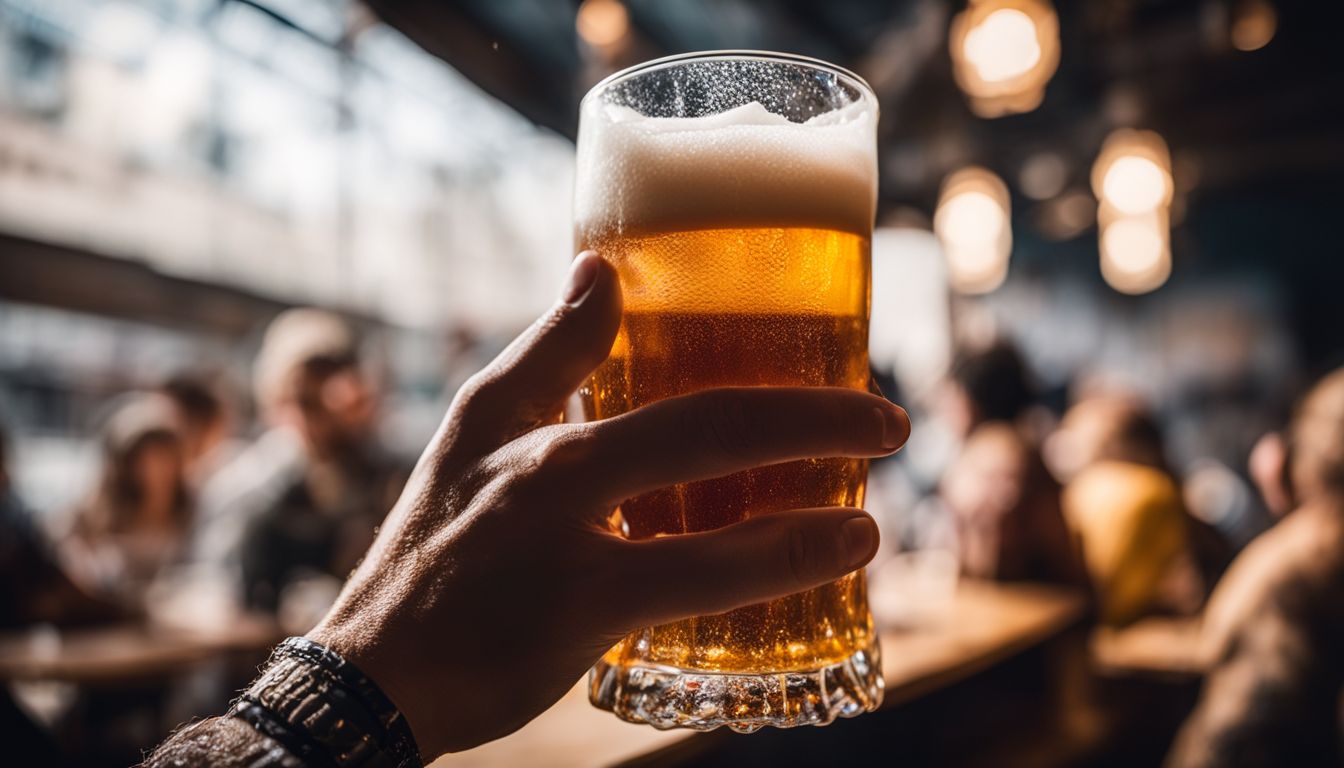
Learn how to pour the perfect pint with different glass types and maintain the ideal temperature for a refreshing beer experience. Discover expert tips on proper glassware care and cleaning for a pristine serving every time.
Plus, find out why mastering these techniques can elevate your beer drinking experience to new heights. Read more to become a beer-serving pro!
Pouring techniques for different glass types

To pour beer properly, it’s important to understand the different techniques for each glass type. For pint glasses, hold the glass at a 45-degree angle and slowly pour the beer down the side until it’s halfway full.
Then, straighten the glass and continue pouring into the center to create a proper head. When using tulip or goblet glasses, tilt them slightly while pouring to release carbonation and enhance aroma.
Pilsner glasses should be held vertically with a gentle pour to maintain carbonation. And when filling sampler glasses, aim for an inch of foam on top to capture all the flavors and aromas.
Maintaining the right temperature
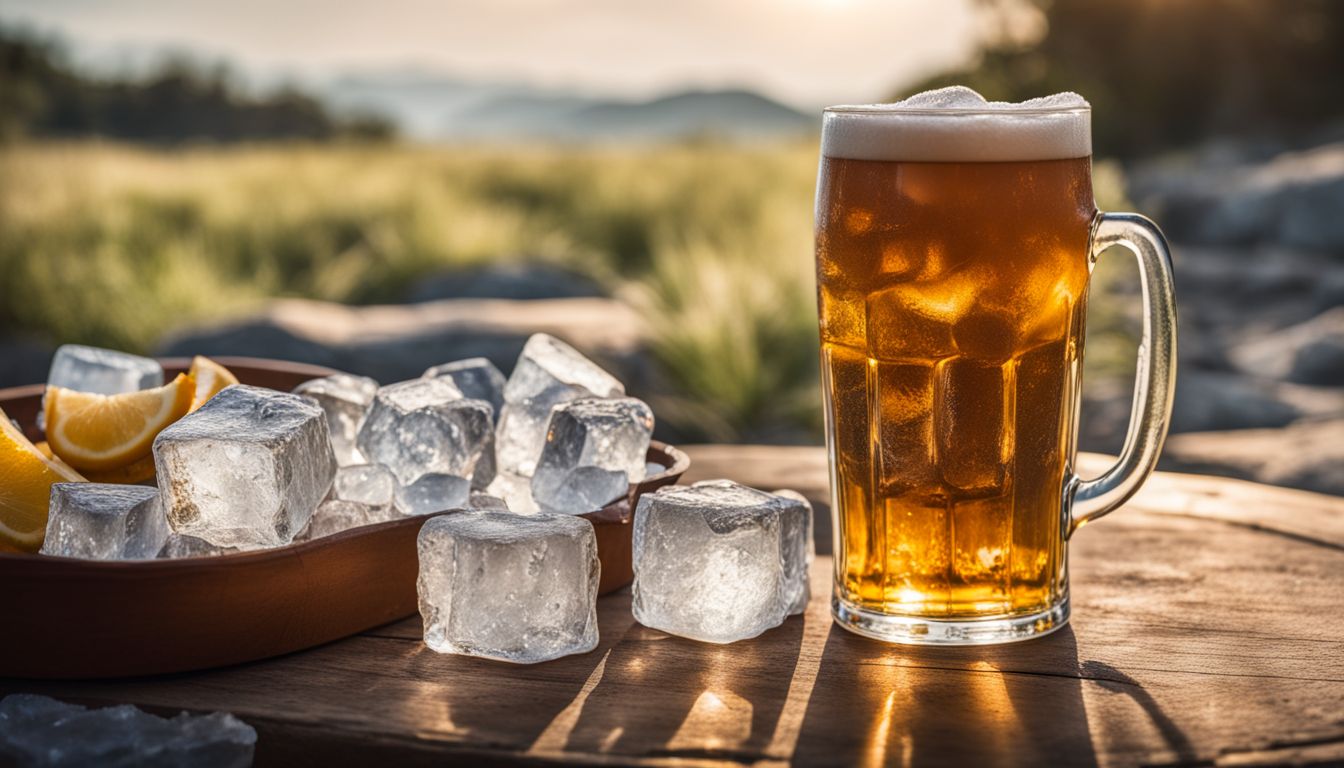
To fully enjoy the flavors and aromas of your beer, it’s important to serve it at the right temperature. Different beer styles have different recommended serving temperatures, so it’s good to know what temperature works best for each type.
For example, lagers are usually best served cold, between 38-45°F (3-7°C), while ales are better enjoyed slightly warmer, around 45-55°F (7-13°C). Stout beers can be served even warmer, at around 50-55°F (10-13°C), to enhance their rich flavors.
Remember that serving your beer too cold can dull its taste, while serving it too warm can make it taste flat or unpleasant. So, when enjoying your favorite brews, keep in mind the ideal serving temperature for maximum enjoyment!
Proper glassware care and cleaning
To keep your beer glasses in top shape, it’s important to take proper care of them. Start by rinsing them with warm water right after using them to remove any residue. Use a soft sponge or cloth to gently wash the glass with mild dish soap, avoiding harsh scrubbing that could scratch the surface.
Rinse thoroughly and allow the glasses to air dry upside down on a clean towel or rack.
When storing your beer glasses, make sure they are completely dry before stacking them. Avoid storing them in a crowded cabinet where they could get bumped or chipped. If you notice any cracks or chips in your glassware, it’s best to replace them as these imperfections can affect the taste and quality of your beer.
Remember that not all beer glasses are dishwasher safe, so be sure to check the manufacturer’s instructions before tossing them into the machine. Hand washing is usually recommended for delicate glassware like tulip glasses or goblets.
Choosing the Right Beer Glass

Consider the characteristics of different beer styles and think about your personal preferences when choosing the perfect glass to enhance your beer drinking experience.
Considerations for beer styles and characteristics
When choosing the right beer glass, it’s important to consider the style and characteristics of the beer you’re drinking. Different styles of beer have unique flavors, aromas, and carbonation levels, which can be enhanced or diminished by the shape and size of the glass.
For example, a tulip glass is ideal for capturing the aromas of hop-forward beers like IPAs, while a pilsner glass showcases the crispness and clarity of light lagers. Additionally, consider factors such as mouthfeel and temperature preferences when selecting a beer glass.
By choosing the right glassware for your beer style, you can enhance your overall drinking experience and fully appreciate the flavors and nuances that each brew has to offer.
Personal preferences and aesthetics
Everyone has their own personal preferences when it comes to beer glassware. Some people prefer a classic pint glass for its simplicity, while others may be drawn to the elegant shape of a tulip or goblet glass.
The size and weight of the glass can also play a role in how enjoyable your beer-drinking experience is. Ultimately, it’s about finding a beer glass that you find visually appealing and comfortable to hold.
Don’t be afraid to experiment with different styles and shapes until you find the one that suits you best. After all, drinking beer is meant to be enjoyable!
Conclusion: Elevating Your Beer Drinking Experience

By understanding the different types of beer glasses and the proper techniques for serving, you can enhance your beer drinking experience. Choosing the right glassware allows you to fully appreciate the flavors, aromas, and visual presentation of your favorite brews.
So next time you enjoy a cold one, grab the appropriate glass and elevate your beer enjoyment to new heights. Cheers!
FAQs
1. Why is glassware important for serving beer?
Glassware is important for serving beer because it enhances the aroma, appearance, and overall drinking experience of different beer styles.
2. What are some common types of beer glassware?
Common types of beer glassware include pint glasses, tulip glasses, pilsner glasses, snifter glasses, and wheat beer glasses.
3. How does the shape of a beer glass affect the taste?
The shape of a beer glass can affect the taste by directing aromas to your nose and allowing carbonation or head retention. It can also highlight certain characteristics of different beers.
4. Are there specific techniques for pouring and serving beer in these different types of glassware?
Yes, there are specific techniques for pouring and serving beer in different types of glassware. For example, pouring at an angle to create a proper head or using stemmed glassware to hold without warming the brew.
